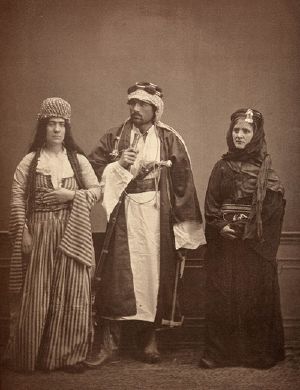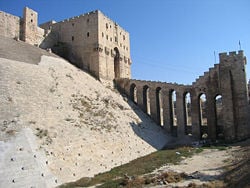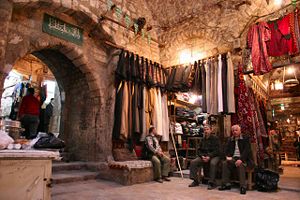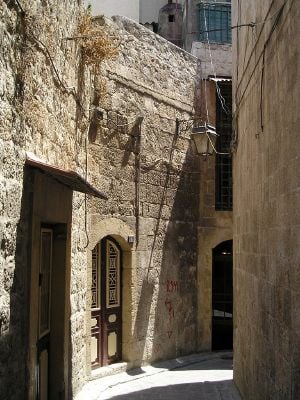Aleppo, Syria
| Line 31: | Line 31: | ||
[[Image:Aleppo_citadel001.jpg|left|thumb|250px|A front view of the Aleppo Citadel]] | [[Image:Aleppo_citadel001.jpg|left|thumb|250px|A front view of the Aleppo Citadel]] | ||
| − | Because the modern city occupies its ancient site, Aleppo has been little touched by archaeologists. The site has been occupied from early in the second millenium B.C.E. It grew as the capital of the kingdom of [[Yamkhad]] | + | Because the modern city occupies its ancient site, Aleppo has been little touched by archaeologists. The site has been occupied from early in the second millenium B.C.E. It grew as the capital of the kingdom of [[Yamkhad]] under the ruling [[Amorite]] dynasty, until the city was overthrown by the Hittites. The Hittite Emperor, Hattusili, had campaigned as far as Yamkhad, when he attacked, but did not capture, Aleppo. His heir, Mursili I, conquered the city in 1595 B.C.E. |
| + | The Hittite campaigns into Syria and Mesopotamia may be responsible for the reintroduction of cuneiform writing into Anatolia, since the Hittite script is quite different from the script of the preceding Assyrian Colony period. | ||
| − | + | The city remained under Hittite control until perhaps 800 B.C.E., before passing through the hands of the [[Assyrian people|Assyrians]] and the [[Persian Empire]]. It was captured by the Greeks in 333 B.C.E.., when [[Seleucus Nicator]] renamed the settlement Beroea, after [[Veria|Beroea]] in [[Macedon]]. The city remained in Greek or [[Seleucid]] hands until 64 B.C.E., when [[Syria]] was conquered by the [[Roman Empire|Romans]]. | |
| − | |||
| − | |||
| − | |||
| − | |||
The city was part of the [[Byzantine Empire|Eastern Roman]] or [[Byzantine Empire]] before falling to [[Muslim conquests|Arab]]s under [[Khalid ibn al-Walid]] in 637 C.E. In the [[tenth century]] a resurgent Byzantine Empire briefly regained control from 974 to 987. The city was twice besieged by [[Crusades|Crusaders]]—in 1098 and in 1124—but was not conquered. It came under the control of [[Saladin]], and then the [[Ayyubid]] Dynasty from 1183 and remained until taken by the [[Mongols]] in 1260. Returning to native control in 1317, decades after the [[Battle of Ain Jalut]], it became part of the [[Ottoman Empire]] in 1517, when the city had around 50,000 inhabitants. | The city was part of the [[Byzantine Empire|Eastern Roman]] or [[Byzantine Empire]] before falling to [[Muslim conquests|Arab]]s under [[Khalid ibn al-Walid]] in 637 C.E. In the [[tenth century]] a resurgent Byzantine Empire briefly regained control from 974 to 987. The city was twice besieged by [[Crusades|Crusaders]]—in 1098 and in 1124—but was not conquered. It came under the control of [[Saladin]], and then the [[Ayyubid]] Dynasty from 1183 and remained until taken by the [[Mongols]] in 1260. Returning to native control in 1317, decades after the [[Battle of Ain Jalut]], it became part of the [[Ottoman Empire]] in 1517, when the city had around 50,000 inhabitants. | ||
| Line 46: | Line 43: | ||
The city remained Ottoman until the empire's collapse, but was occasionally riven with internal feuds as well as attacks of the [[Black Death|plague]] and later [[cholera]] from 1823. By 1901 its population was around 125,000. The city revived when it came under French colonial rule but slumped again following the decision to give [[Antioch]] to [[Turkey]] in 1938-1939. | The city remained Ottoman until the empire's collapse, but was occasionally riven with internal feuds as well as attacks of the [[Black Death|plague]] and later [[cholera]] from 1823. By 1901 its population was around 125,000. The city revived when it came under French colonial rule but slumped again following the decision to give [[Antioch]] to [[Turkey]] in 1938-1939. | ||
| − | Aleppo was named by the Islamic Educational Scientific and Cultural Organization (ISESCO) as the capital of Islamic culture in 2006 | + | Aleppo was named by the Islamic Educational Scientific and Cultural Organization (ISESCO) as the capital of Islamic culture in 2006, in "recognition of the historical, civilizational, and cultural status of Aleppo, and in celebration of its historical and civilizational monuments which stand witness to an age-old past of which the roots spread to pre-historical times and stretch through Arab and Islamic eras." Indeed, with its thirteenth-century citadel, twelfth-century Great Mosque, and various seventeenth-century madrasas, palaces, caravanserais, and hammams, Aleppo, as a major historical crossroads, recalls the Hittites, Assyrians, Arabs, Mongols, Mamelukes and Ottomans civilizations and cultures that dwelled there over the centuries. |
| − | |||
| − | |||
| − | |||
==Design== | ==Design== | ||
| Line 65: | Line 59: | ||
The city has many [[mosque]]s including the [[Madrasa Halawiya]]. A temple that once stood on the site was rebuilt as Aleppo's great [[Byzantine architecture|Byzantine]] cathedral founded by [[Helena of Constantinople|Saint Helena]], mother of [[Constantine the Great]], which contains a tomb associated with [[Zechariah (priest)|Zachary]], father of [[John the Baptist]]. During the [[Crusade]]s, when the invaders pillaged the surrounding countryside, the city's chief judge converted St. Helena's cathedral into a mosque, and in the middle of the [[twelfth century]] the famous leader [[Nur al-Din]] founded the ''[[madrasa]]'' (or religious school) that has encompassed the former cathedral. The [[Jami al-Kabir]] or "Great Mosque" was originally built by the [[Umayyads]], although the present structure begun for Nur al-Din dates from 1158 and a rebuilding after the [[Mongol]] invasion of 1260. | The city has many [[mosque]]s including the [[Madrasa Halawiya]]. A temple that once stood on the site was rebuilt as Aleppo's great [[Byzantine architecture|Byzantine]] cathedral founded by [[Helena of Constantinople|Saint Helena]], mother of [[Constantine the Great]], which contains a tomb associated with [[Zechariah (priest)|Zachary]], father of [[John the Baptist]]. During the [[Crusade]]s, when the invaders pillaged the surrounding countryside, the city's chief judge converted St. Helena's cathedral into a mosque, and in the middle of the [[twelfth century]] the famous leader [[Nur al-Din]] founded the ''[[madrasa]]'' (or religious school) that has encompassed the former cathedral. The [[Jami al-Kabir]] or "Great Mosque" was originally built by the [[Umayyads]], although the present structure begun for Nur al-Din dates from 1158 and a rebuilding after the [[Mongol]] invasion of 1260. | ||
| + | |||
| + | |||
| + | [The mosque is arranged around a vast courtyard that connects to different areas of the mosque that are placed behind the colonnaded arcade. The courtyard is famous for its black and white stone pavement that forms complex geometric patterns. The courtyard holds the two ablutions fountains. | ||
| + | |||
| + | The main prayer hall holds the key elements of the mosque: the shrine of Zachariah (father of John the Baptist), a fifteenth century minbar, and an elaborately carved mihrab. This large prayer hall originally had a basic straight rooftop with a central dome but was replaced by the Mamluks with an intricate cross-vaulted system with arches and a small dome over the arcades. The mosque has recently (2003) undergone a renovation, during this project the courtyard and the minaret were attended to.] | ||
==Aleppo today== | ==Aleppo today== | ||
Revision as of 15:34, 29 August 2007
| Ancient City of Aleppo* | |
|---|---|
| UNESCO World Heritage Site | |
Skyline of Aleppo | |
| State Party | |
| Type | Cultural |
| Criteria | iii, iv |
| Reference | 21 |
| Region** | Arab States |
| Inscription history | |
| Inscription | 1986 (10th Session) |
| * Name as inscribed on World Heritage List. ** Region as classified by UNESCO. | |
Aleppo (Arabic Halab) is a city in northern Syria, second largest city in Syria after Damascus, and one of the oldest inhabited cities in history. The Hittites first settled Aleppo in 1595 B.C.E. Aleppo, going back to the early second millennium B.C.E., competes with Damascus on being the oldest inhabited city in the world.
The city was known in antiquity as Khalpe, Khalibon and Beroea (Veroea). To the Turks it was known as Halep, and during the French Mandate it came to be called Alep. It occupies a strategic trading point midway between the sea and the Euphrates.
The main role of the city was as a trading place, as it sat at the crossroads of two trade routes and mediated the trade from India, the Tigris-Euphrates regions, and the route from Damascus in the South. In the third century C.E., Aleppo was the greatest center of trade between Europe and lands farther east.
Although trade was often directed away from the city for political reasons, it continued to thrive until the Europeans began to use the Cape route to India, and later to utilize the route through Egypt to the Red Sea. Since then, the city has declined as a trading center and its chief exports now are the agricultural products of the surrounding region, mainly wheat and cotton, pistachios, olives, and sheep.
Aleppo was selected as a UNESCO World Heritage Site in 1986, based upon two criteria: It bears a unique or at least exceptional testimony to a cultural tradition or to a civilization which is living or which has disappeared; and, it is an outstanding example of a type of building, architectural or technological ensemble or landscape which illustrates a significant stage in human history. The UNESCO selection committee further cites that the city's great collection of architecture from diverse cultures and civilizations "all form part of the city's cohesive, unique urban fabric, now threatened by overpopulation."
History
The name Halab (Arabic for Aleppo) is of obscure origins. Some proposed that it means the metals of iron or copper in Amorite languages since it was a major source of these metals in antiquity. Halaba in Aramaic means white, referring to the color of soil and marble abundant in the area. Another proposed etymology is that the name Halab means "gave out milk," coming from the ancient tradition that the Hebrew patriarch Abraham gave milk to travelers as they moved throughout the region. The color of his cows was ashen (Arab. shaheb), therefore the city is also called Halab ash-Shahba (he milked the ash-colored).
Because the modern city occupies its ancient site, Aleppo has been little touched by archaeologists. The site has been occupied from early in the second millenium B.C.E. It grew as the capital of the kingdom of Yamkhad under the ruling Amorite dynasty, until the city was overthrown by the Hittites. The Hittite Emperor, Hattusili, had campaigned as far as Yamkhad, when he attacked, but did not capture, Aleppo. His heir, Mursili I, conquered the city in 1595 B.C.E.
The Hittite campaigns into Syria and Mesopotamia may be responsible for the reintroduction of cuneiform writing into Anatolia, since the Hittite script is quite different from the script of the preceding Assyrian Colony period.
The city remained under Hittite control until perhaps 800 B.C.E., before passing through the hands of the Assyrians and the Persian Empire. It was captured by the Greeks in 333 B.C.E., when Seleucus Nicator renamed the settlement Beroea, after Beroea in Macedon. The city remained in Greek or Seleucid hands until 64 B.C.E., when Syria was conquered by the Romans.
The city was part of the Eastern Roman or Byzantine Empire before falling to Arabs under Khalid ibn al-Walid in 637 C.E. In the tenth century a resurgent Byzantine Empire briefly regained control from 974 to 987. The city was twice besieged by Crusaders—in 1098 and in 1124—but was not conquered. It came under the control of Saladin, and then the Ayyubid Dynasty from 1183 and remained until taken by the Mongols in 1260. Returning to native control in 1317, decades after the Battle of Ain Jalut, it became part of the Ottoman Empire in 1517, when the city had around 50,000 inhabitants.
On August 9, 1138, a deadly earthquake ravaged the city and the surrounding area. Although estimates from this time are very unreliable, it is believed that 230,000 people died, making it the fourth deadliest earthquake in recorded history.
The city remained Ottoman until the empire's collapse, but was occasionally riven with internal feuds as well as attacks of the plague and later cholera from 1823. By 1901 its population was around 125,000. The city revived when it came under French colonial rule but slumped again following the decision to give Antioch to Turkey in 1938-1939.
Aleppo was named by the Islamic Educational Scientific and Cultural Organization (ISESCO) as the capital of Islamic culture in 2006, in "recognition of the historical, civilizational, and cultural status of Aleppo, and in celebration of its historical and civilizational monuments which stand witness to an age-old past of which the roots spread to pre-historical times and stretch through Arab and Islamic eras." Indeed, with its thirteenth-century citadel, twelfth-century Great Mosque, and various seventeenth-century madrasas, palaces, caravanserais, and hammams, Aleppo, as a major historical crossroads, recalls the Hittites, Assyrians, Arabs, Mongols, Mamelukes and Ottomans civilizations and cultures that dwelled there over the centuries.
Design
There is a relatively clear division between old and new Aleppo. The former is enclosed within a wall, three miles around with seven gates, dating from medieval times. The medieval castle in the city—known as the Citadel of Aleppo—is built atop a huge, partially artificial mound rising 164 feet above the city. The current structure, surrounded by a moat, dates from the thirteenth century and had been extensively damaged by earthquakes, notably in 1822.
As an ancient trading center, Aleppo also has impressive suqs (shopping streets) and khan (commercial courtyards). The city was significantly redesigned after World War II; in 1952 the French architect Andre Gutton had a number of wide new roads cut through the city to allow easier passage for modern traffic. In the 1970s, large parts of the older city were demolished to allow for the construction of modern apartment buildings.
Population and religion
While more than 70 percent of Aleppo's inhabitants are Sunni Muslims (mainly Arabs, but also Kurds, and other diverse ethnicities relocated there during the Ottoman period, most notably Circassians, Adyghe, Albanians, Bosnians, Bulgars, Turks, Kabardins, Chechens, and others), Aleppo is home to one of the richest and most diversified Christian communities of the Orient. Christians belonging to a dozen different congregations (with prevalence of the Armenian and Syriac Orthodox Church and other Orthodox denominations) represent between 15 percent and 20 percent of its population, making it the city with the second biggest Christian community in the Middle East after Beirut, Lebanon.

The city had a large Jewish population in ancient times, traditionally since the period of King David. The great synagogue housed the famous Aleppo codex, dating back to the ninth century. The codex is now housed in Jerusalem. The vast majority of Aleppo's 10,000 Jewish residents moved abroad after the creation of the state of Israel due to various social and political pressures.
There are no more Jewish families who still live in Aleppo today, and the synagogue remains virtually empty. At one point it was a thriving Jewish community, especially under the guidance of the Chief Rabbi Jacob Dwek and his brother in law Rabbi Ezra Soued. Their offspring have since settled around the world in such places as the United States. (Syrian Jews mostly moved to Brooklyn, New York, where there is still an ethnic community called Little Syria); Brazil; and other countries, by dint of the efforts of the Canadian musician Judy Feld Carr, which secured the right to emigrate of almost all Syrian Jews from the pressures of the Syrian government and population.
The city has many mosques including the Madrasa Halawiya. A temple that once stood on the site was rebuilt as Aleppo's great Byzantine cathedral founded by Saint Helena, mother of Constantine the Great, which contains a tomb associated with Zachary, father of John the Baptist. During the Crusades, when the invaders pillaged the surrounding countryside, the city's chief judge converted St. Helena's cathedral into a mosque, and in the middle of the twelfth century the famous leader Nur al-Din founded the madrasa (or religious school) that has encompassed the former cathedral. The Jami al-Kabir or "Great Mosque" was originally built by the Umayyads, although the present structure begun for Nur al-Din dates from 1158 and a rebuilding after the Mongol invasion of 1260.
[The mosque is arranged around a vast courtyard that connects to different areas of the mosque that are placed behind the colonnaded arcade. The courtyard is famous for its black and white stone pavement that forms complex geometric patterns. The courtyard holds the two ablutions fountains.
The main prayer hall holds the key elements of the mosque: the shrine of Zachariah (father of John the Baptist), a fifteenth century minbar, and an elaborately carved mihrab. This large prayer hall originally had a basic straight rooftop with a central dome but was replaced by the Mamluks with an intricate cross-vaulted system with arches and a small dome over the arcades. The mosque has recently (2003) undergone a renovation, during this project the courtyard and the minaret were attended to.]
Aleppo today
The city is now an agricultural trading center and has factories producing carpets; silk, cotton, and wool textiles; silverware and goldware; leather goods; and embroidery. Chief exports are the agricultural products of the surrounding region, mainly wheat and cotton, pistachios, olives, and sheep. Aleppo has a number of European schools and Christian churches and missions. The University of Halab was founded in 1960. The city is connected by rail with Damascus, and with Beirut, Lebanon], and by caravan route with Iraq and parts of Kurdistan.
Aleppo has a population of 1.9 million. The province (or governorate) extends around the city for over 6,178 square miles and has around 3.7 million inhabitants
Notable people
- Paul of Aleppo, seventeenth century Archdeacon of Aleppo, traveler and chronicler.
- Chessplayer and writer Phillip Stamma was born in 1705 .
- Ali Sadreddine Bayanouni, deputy leader of the Muslim Brotherhood in 1977.
- Muhammed Faris (born 1951), first Syrian cosmonaut.
- Adnan Dabbagh, former minister of interior of Syria.
- Moustapha Akkad, film producer and director, born in 1935.
- George Tutunjian– Famous Armenian Revolutionary Songs performer.
- Levon Ter-Petrossian, former president of the Republic of Armenia.
Photo gallery
- Aleppoaleppoaleppo.jpg
The National Park is in the heart of the city
- Aleppoaleppo.jpg
Citadel of Aleppo is the most famous monument in the city
- Citadel-amphitheatre.jpg
The amphitheater inside the citadel
- Byzantine-hall.jpg
The Byzantine hall inside the citadel
- AleppoViewFromCitadel.jpg
Old Aleppo (view from the citadel)
- Aleppomosque.jpg
Ar-Rahman (The Gracious) mosque in Al-Sabil neighborhood
- MapAleppo 1912.jpg
The famous clock tower of Bab el-faraj (literally the Gate of Salvation; named after one of many gates of old Aleppo
- ChurchofAleppo.jpg
St. Simon (Samaan) church is considered to be one of the oldest remained churches in the world.
ReferencesISBN links support NWE through referral fees
- Borneman, John. Syranian Episodes: Sons, Fathers, and an Anthropologist in Aleppo, Princeton University Press, 2007. ISBN 978-0691128870
- Marcus, Abraham. The Middle East on the Eve of Modernity: Aleppo in the 18th Century, Columbia University Press, 1992. ISBN 978-0231065955
- Rabbo, Annika. A Shop of One's Own: Independence and Reputation Among Traders in Aleppo, I.B. Tauris, 2005. ISBN 978-1850436836
- Sabato, Haim. Aleppo Tales, Toby Press, 2005. ISBN 978-1592641260
- Sutton, David. Aleppo: City of Scholars, Mesorah Publications, 2005. ISBN 978-1578190560
External links
- Lynn Simarski, 'The lure of Aleppo" history and architecture.
- Armenian history and presence in Aleppo
- University of Aleppo
- [http://www.aleppocitadelfriends.org Aleppo Citadel Friends - Local non-profit with information on old city and citadel.
- A walk through Aleppo from a www.oldworldwandering.com/ travelogue] *pictures
- A large picture gallery about Aleppo, sorted after the old, the modern city and the souk.
- Citadel of Aleppo, inside and outside.
- A collection of pictures made in 2003 on Aleppo (a mosque, the Citadel, the souk).
- Pictures of Aleppo
- 'Ittihad club of Aleppo" forum for local sport and Aleppo community .
- 'Jalaa Club of Aleppo" Local basketball team and rivals of Ittihad .
Credits
New World Encyclopedia writers and editors rewrote and completed the Wikipedia article in accordance with New World Encyclopedia standards. This article abides by terms of the Creative Commons CC-by-sa 3.0 License (CC-by-sa), which may be used and disseminated with proper attribution. Credit is due under the terms of this license that can reference both the New World Encyclopedia contributors and the selfless volunteer contributors of the Wikimedia Foundation. To cite this article click here for a list of acceptable citing formats.The history of earlier contributions by wikipedians is accessible to researchers here:
The history of this article since it was imported to New World Encyclopedia:
Note: Some restrictions may apply to use of individual images which are separately licensed.



